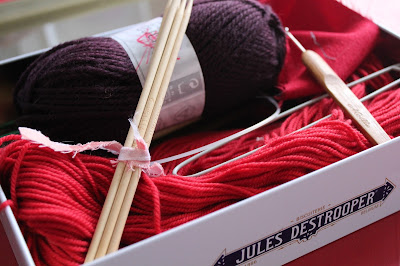When two worlds meet...
It's not often that my job and my
hobbies intersect. But in March I had the opportunity to bring in
the world of handcrafting to the world of language learning. I
currently have a group of students who work in service design. A big
part of their job is to try to improve systems or physical
objects/interfaces to be more user-friendly. And in order to do that
they follow certain principles, for example, described by Don Norman
in his book The Design of Everyday Things. One of these
principles is the idea that a person should be able to easily
understand what an object does upon first encountering it. For
example, what do you do with a knob ? You turn it. But do you
turn a lever ? No, you pull it.
So to foster a discussion about the
design of everyday objects and how to understand and perhaps improve
them with the user in mind, I brought in some everyday objects.
Everyday objects for certain people that is ! My goal was to
choose objects perhaps unfamiliar to the group, but whose use should
be readily discernible. I brought in various types of knitting
needles, sewing needles, thread and yarn, and accessories to those
trades, like a seam ripper and knitting markers. I then let the
group discover the objects, handle them, etc. and try to explain or
demonstrate their use. Before going on to discuss in detail the
differences : What is the purpose/advantage of using wood for
the knitting needles, versus plastic or metal ? Why does this
crochet hook have an indentation here but the other doesn't ?
Is one design better than another, etc ?
 | ||
| The box of goodies I used with my students. |
The group (made up entirely of men who
don't practice handicrafts) was able to suss out the purpose of all
the objects, except the double-pointed needles. And the discussion
was extremely fruitful ! It helped them develop vocabularly to
describe different physical qualities, as well as to describe how to
improve something or explain why it needs improving. So I felt like
this was a positive exercise in terms of language learning.
But not only ! I also felt like
this was a positive exercise by helping to break down gender
stereotypes, and other prejudices. I was hesitant to bring in these
objects to a group of men (and on the second class, no less) because
of gender stereotypes in our culture. First of all, the idea that
men don't really sew or knit, etc, which is erroneous. And the ideas that pigeon-hole
these activities as the domain of specific types of women, namely grandmothers and unmarried women who have nothing better to do because they don't have a man. I still
hear comments like these all the. This is an
injustice to all concerned on so many levels! Anyhow, the
feedback from the group was very positive and they said they very
much appreciated the tactile aspect of the lesson. So, a win-win.
I also thought about doing the same
exercise, but with feminine hygiene products. As I didn't know the
group very well, I ultimately decided that bringing in the
knitting/sewing products was probably challenging enough. I thought
that the feminine hygiene products could be seen as agressive. It's
sad that this is the case. Maybe it would have been just fine, but I
didn't risk it. The fact is that tampons and cups and napkins are
all designed products just as much as other products, and by men as
well as by women. So these should not be taboo. Speaking of which,
if you haven't heard of SheThinx
yet, I highly recommend checking it out. I'm a user and I am not
kidding when I say it has changed my life.
Speaking of changes and design and all
that ! The blog has a new look ! I did this on a whim. I
liked the old look, but since it had been a while since my last post,
I decided to go ahead and freshen it up. What do you think about the
new interface ?

The gender aspect of your activity is really interesting, and I'm glad to hear it went well. Have you thought about drilling down to gender aspects regarding the design of the knitting instruments? Not for your class maybe but just as an intellectual exercise? One of the things I remember from reading Susan Faludi's Backlash* is how a lot of products meant for female users are actually designed by men. How much involvement have women had in the design, manufacturing and marketing of the knitting stuff? I don't know, but it arouses my curiosity.
ReplyDelete*This came out in 1991. Surprised I can remember anything going back that far!
I remember reading it as a teenager because you recommended it to me! And yes, it's an interesting question of empowerment. Not just about design, but about the establishment of health policies, etc. of one group of people for another group of people.
Delete